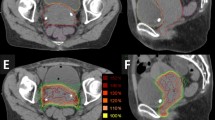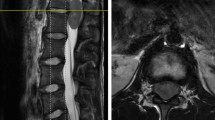Background:
Leptomeningeal carcinomatosis occurs in about 5% of solid tumors and may seriously compromise quality of life. Aim of the present study was to evaluate the feasibility of craniospinal irradiation with and without intrathecal chemotherapy and its efficacy with regard to symptom palliation and survival.
Patients and Methods: 16 patients (mean age 46 years; nine breast cancers, five lung cancers, one renal cell cancer, one tumor of unknown primary site) with leptomeningeal carcinomatosis occurring after a median interval from primary tumor diagnosis of 5 months (0–300 months) received craniospinal irradiation between October 1995 and May 2000. The median total dose was 36 Gy (à 1.6–2.0 Gy). Ten patients were additionally treated with intrathecal methotrexate (15 mg per cycle, 2–8 cycles).
Results: Median survival was 12 weeks, 8 weeks after radiotherapy alone, 16 weeks after combined modality treatment. 14 patients died from disease. Eleven patients (68%) experienced regression of their neurological symptoms during or soon after completion of radiotherapy. Seven patients regained their ability to walk, six had pain reduction, three regression of bladder and bowel incontinence. In three patients symptom progression and in two patients no change occurred. Side effects were: myelosuppression (CTC) Grade I: n = 2, Grade II: n = 4, Grade III: n = 4 patients and Grade IV: n = 1. Nine patients had dysphagia, seven mucositis, three suffered from nausea. No late toxicity was observed.
Conclusion: Craniospinal radiotherapy is feasible and effective for palliative treatment of leptomeningeal carcinomatosis. As far as the small patient number permits any definite conclusions, combined modality treatment seems superior to irradiation alone.
Hintergrund:
Eine Leptomeningeosis carcinomatosa, die bei ca. 5% aller soliden Tumoren auftritt, kann die Lebensqualität erheblich beeinträchtigen. Ziel der Studie war es, Machbarkeit und Effektivität einer kraniospinalen Bestrahlung mit und ohne intrathekale Chemotherapie in Bezug auf neurologische Ausfälle und Überleben zu untersuchen.
Patienten und Methodik: 16 Patient/innen (medianes Alter 46 Jahre; neun Mammakarzinome, füf Bronchialkarzinome, ein Nierenzellkarzinom, ein unbekannter Primärtumor) mit Meningeosis carcinomatosa, die nach einem medianen Intervall zur Erstdiagnose von 5 Monaten (0–300 Monaten) auftrat, erhielten zwischen Oktover 1995 und Mai 2000 eine Bestrahlung der Neuroachse mit einer medianen Dosis von 36 Gy (à 1,6–2,0 Gy). Zehn Patienten erhielten zusätzlich zwei- bis achtmal eine intrathekale Chemotherapie mit jeweils 15 mg MTX.
Resultate: Das mediane Überleben ab Nachweis der Meningeosis betrug 12 Wochen (4–84 Wochen), nach alleiniger Radiatio 8 Wochen, nach kombinierter Therapie 16 Wochen. 14 Patienten verstarben tumorbedingt. Bei elf Patienten (68%) trat während bzw. unmittelbar im Anschluss an die Radiatio ein anhaltender Rückgang der neurologischen Beschwerdesymptomatik ein (siebenmal Wiedererlangung der Gehfähigkeit, sechsmal Schmerzreduktion, dreimal Rückbildung der Blasen- und Mastdarmstörungen). Bei drei Patienten bestand unter Therapie einer Progression der Symptome, in zwei Fällen ein Status idem. Nebenwirkungen waren: Hämatotoxizität (CTC) Grad I: n = 2, Grad II: n = 4, Grad III: n = 4, Grad IV: n = 1. Schluckbeschwerden traten bei neun, eine Mukositis bei sieben und Übelkeit bei drei Patienten auf.
Schlussfolgerung: Durch Bestrahlung der Neuroachse ist bei Meningeosis carcinomatosa ein substantieller palliativer Effekt auf die neurologische Symptomatik bei akzeptablen Nebenwirkungen erzielbar. Sofern bei der geringen Fallzahl zu beurteilen, erscheint eine Verlängerung der Überlebenszeit nur durch Kombination mit einer intrathekalen MTX-Chemotherapie erzielbar.
Similar content being viewed by others
Author information
Authors and Affiliations
Additional information
Received: June 28, 2000; accepted: September 15, 2000
Rights and permissions
About this article
Cite this article
Hermann, B., Hültenschmidt, B. & Sautter-Bihl, ML. Radiotherapy of the Neuroaxis for Palliative Treatment of Leptomeningeal Carcinomatosis. Strahlenther Onkol 177, 195–199 (2001). https://doi.org/10.1007/PL00002398
Issue Date:
DOI: https://doi.org/10.1007/PL00002398




